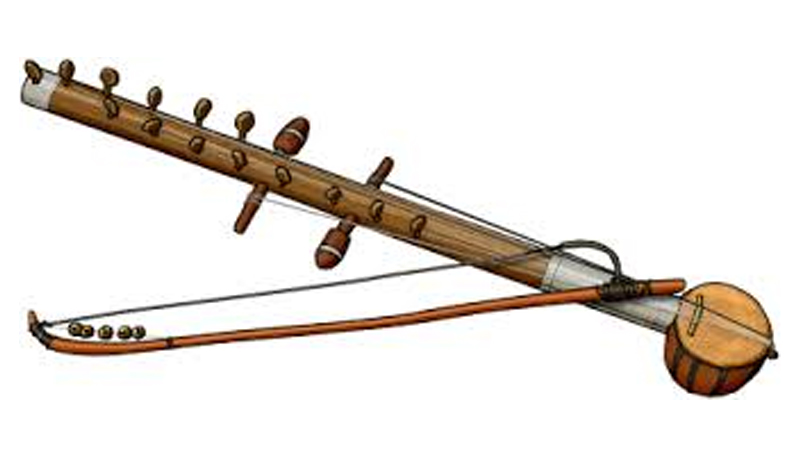রাবণহাতা

রাবণহাতা হল ভারত, শ্রীলঙ্কা এবং আশেপাশের অঞ্চলে ব্যবহৃত একটি ধনুকসদৃশ ও বেহালা বা বীণাজাতীয় এবং তারযুক্ত প্রাচীন বাদ্যযন্ত্র। রাবণহাতা ছাড়াও অঞ্চলভেদে এটি রাবণহত্ত, রাবণহস্ত, রাবণহত্থ, রাবণস্ত্রোণ এবং রাবণ হস্তবীণা ইত্যাদি নামে পরিচিত। কেউ কেউ এটিকে বেহালার পূর্বপুরুষ বলেও মনে করে থাকেন।
গঠনশৈলী
রাবণহাতার মূল শব্দোৎপাদক অংশ বা সাউন্ড বক্সের কাঠামোটি লাউ, অর্ধেক নারিকেলের খোল বা কাঠের ফাঁপা স্তম্ভ দিয়ে তৈরি করা হয় এবং সবশেষে ছাগল বা অন্য কোন প্রাণীর চামড়া দিয়ে মূলকাঠামো ঢেকে দেওয়া হয়। এতে কাঠ বা বাঁশের একটি ঘাড় সংযুক্ত থাকে।
আধুনিক ব্যবহার
দীনেশ সুবসিংহে রাবণহাতার নতুন সংস্করণটি দেখাচ্ছেন শ্রীলঙ্কার প্রধানমন্ত্রী মহিন্দা রাজাপাকসাকে
আধুনিক কালে ই বাদ্যযন্ত্রটি শ্রীলঙ্কান সুরকার ও বেহালাবাদক দীনেশ সুবসিংহে দ্বারা পুনর্জাগরিত হয়েছে। তিনি রাবণ নদ ও করুণা নদী সহ তার বেশ কিছু গানে বাদ্যযন্ত্রটি ব্যবহার করেছেন।
ইউরোপীয় পরীক্ষামূলক লোকসঙ্গীত দল হেইলুং তাদের ওফনির এবং ফুথা উভয় অ্যালবামেই রাবণহাতার ব্যবহার করেছে।
A ravanahatha (variant names: ravanhatta, rawanhattha, ravanastron, ravana hasta veena) is an ancient bowed, stringed instrument, used in India, Sri Lanka and surrounding areas. It has been suggested as an ancestor of the violin.
The ravanahatha's sound box may be a gourd, a halved coconut shell or hollowed-out cylinder of wood, with a membrane of stretched goat or other hide. A neck of wood or bamboo is attached, carrying between one and four or more peg-tuned strings of gut, hair or steel, strung over a bridge. Some examples may have several sympathetic strings. The bow is usually of horsehair; examples vary in length.
In Indian and Sri Lankan tradition, the ravanahatha is believed to have originated among the Hela people of Lanka during the time of the legendary king Ravana, after whom the instrument is supposedly named. According to legend, Ravana used the ravanahatha in his devotions to the Hindu God Shiva. In the Hindu Ramayana epic, after the war between Rama and Ravana, Hanuman returned to North India with a ravanahatha. The ravanahatha is particularly popular among street musicians in Rajasthan, North India.
Throughout the history of Medieval India, the kings were patrons of music; this helped in increased popularity of the ravanhatha among royal families. In Rajasthan and Gujarat, it was the first musical instrument to be learned by princes. The Sangit tradition of Rajasthan further helped in popularizing ravanhatta among women.
वर्गीकरण
- Log in to post comments
- 1444 views
